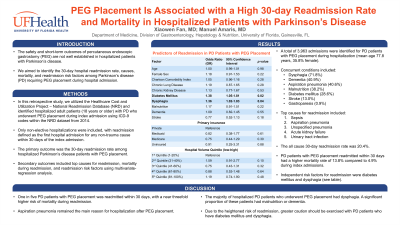Tuesday Poster Session
Category: General Endoscopy
P3392 - PEG Placement Is Associated with a High 30-day Readmission Rate and Mortality in Hospitalized Patients with Parkinson’s Disease
Tuesday, October 24, 2023
10:30 AM - 4:00 PM PT
Location: Exhibit Hall

Has Audio
- XF
Xiaowen Fan, MD
University of Florida
Gainesville, FL
Presenting Author(s)
Xiaowen Fan, MD, Manuel Amaris, MD
University of Florida, Gainesville, FL
Introduction: The safety and short-term outcomes of percutaneous endoscopic gastrostomy (PEG) are not well established in hospitalized patients with Parkinson’s disease. We aimed to identify the 30-day hospital readmission rate, causes, mortality, and readmission risk factors among Parkinson’s disease (PD) requiring PEG placement during hospital admission.
Methods: In this retrospective study, we utilized the Healthcare Cost and Utilization Project – National Readmission Database (NRD) and identified hospitalized adult patients (18 years or older) with PD who underwent PEG placement during index admission using ICD-9 codes within the NRD dataset from 2014. Only non-elective hospitalizations are included, with readmission defined as the first hospital admission for any non-trauma cause within 30 days of the index admission. The primary outcome was the 30-day readmission rate. Secondary outcomes included top causes for readmission, mortality during readmission, and readmission risk factors using multivariate-regression analysis.
Results: A total of 3,963 admissions were identified for PD patients with PEG placement during hospitalization (mean age 77.8 years, 35.8% female). Concurrent conditions included dysphagia (71.8%), aspiration pneumonia (40.6%), dementia (40.9%), malnutrition (38.2%), diabetes mellitus (28.6%), and stroke (13.0%). Gastroparesis was diagnosed in only 0.9% of admissions. The 30-day readmission rate was 20.4%. Top readmission diagnoses were sepsis, aspiration pneumonia, unspecified pneumonia, acute kidney failure, and urinary tract infection. PD patients with PEG placement readmitted within 30 days had a higher mortality rate of 13.8% compared to 4.9% during index admissions. Independent risk factors for readmission were diabetes mellitus and dysphagia (see table).
Discussion: One in five PD patients with PEG placement was readmitted within 30 days, with a near threefold higher risk of mortality during readmission. Aspiration pneumonia remained the main reason for hospitalization after PEG placement. The majority of hospitalized PD patients who underwent PEG placement had dysphagia. A significant proportion of these patients had malnutrition or dementia. Due to the heightened risk of readmission, greater caution should be exercised with PD patients who have diabetes mellitus and dysphagia.
Disclosures:
Xiaowen Fan, MD, Manuel Amaris, MD. P3392 - PEG Placement Is Associated with a High 30-day Readmission Rate and Mortality in Hospitalized Patients with Parkinson’s Disease, ACG 2023 Annual Scientific Meeting Abstracts. Vancouver, BC, Canada: American College of Gastroenterology.
University of Florida, Gainesville, FL
Introduction: The safety and short-term outcomes of percutaneous endoscopic gastrostomy (PEG) are not well established in hospitalized patients with Parkinson’s disease. We aimed to identify the 30-day hospital readmission rate, causes, mortality, and readmission risk factors among Parkinson’s disease (PD) requiring PEG placement during hospital admission.
Methods: In this retrospective study, we utilized the Healthcare Cost and Utilization Project – National Readmission Database (NRD) and identified hospitalized adult patients (18 years or older) with PD who underwent PEG placement during index admission using ICD-9 codes within the NRD dataset from 2014. Only non-elective hospitalizations are included, with readmission defined as the first hospital admission for any non-trauma cause within 30 days of the index admission. The primary outcome was the 30-day readmission rate. Secondary outcomes included top causes for readmission, mortality during readmission, and readmission risk factors using multivariate-regression analysis.
Results: A total of 3,963 admissions were identified for PD patients with PEG placement during hospitalization (mean age 77.8 years, 35.8% female). Concurrent conditions included dysphagia (71.8%), aspiration pneumonia (40.6%), dementia (40.9%), malnutrition (38.2%), diabetes mellitus (28.6%), and stroke (13.0%). Gastroparesis was diagnosed in only 0.9% of admissions. The 30-day readmission rate was 20.4%. Top readmission diagnoses were sepsis, aspiration pneumonia, unspecified pneumonia, acute kidney failure, and urinary tract infection. PD patients with PEG placement readmitted within 30 days had a higher mortality rate of 13.8% compared to 4.9% during index admissions. Independent risk factors for readmission were diabetes mellitus and dysphagia (see table).
Discussion: One in five PD patients with PEG placement was readmitted within 30 days, with a near threefold higher risk of mortality during readmission. Aspiration pneumonia remained the main reason for hospitalization after PEG placement. The majority of hospitalized PD patients who underwent PEG placement had dysphagia. A significant proportion of these patients had malnutrition or dementia. Due to the heightened risk of readmission, greater caution should be exercised with PD patients who have diabetes mellitus and dysphagia.
Disclosures:
Xiaowen Fan indicated no relevant financial relationships.
Manuel Amaris indicated no relevant financial relationships.
Xiaowen Fan, MD, Manuel Amaris, MD. P3392 - PEG Placement Is Associated with a High 30-day Readmission Rate and Mortality in Hospitalized Patients with Parkinson’s Disease, ACG 2023 Annual Scientific Meeting Abstracts. Vancouver, BC, Canada: American College of Gastroenterology.
